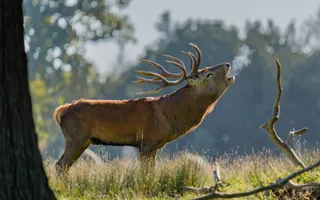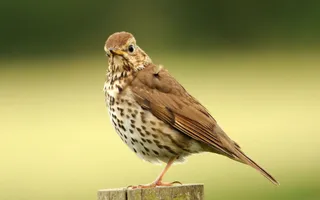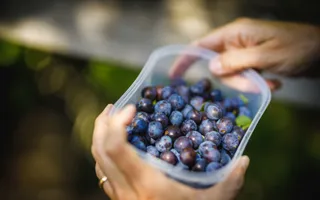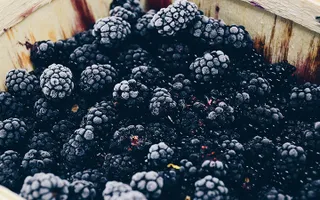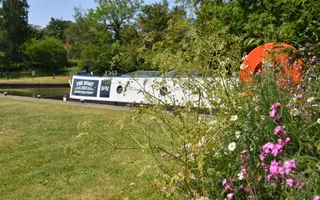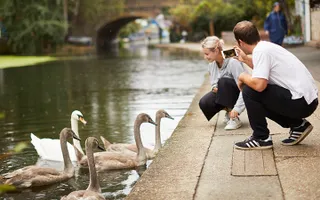A sensory guide to spotting winter wildlife
While winter may look quiet for wildlife, there's a lot taking place in the hedgerows and the towpaths. Our senior ecologist, Paul Wilkinson, shares his top sensory tips to make the most of your visit.

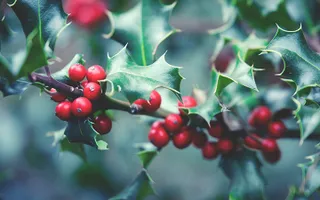
Winter is a great time to experience the tactile elements of nature. Whether it's kicking up crunchy leaves or gently touching holly leaves, winter offers unique sensory experiences. Some leaves break down quickly, while others, like oak, hornbeam and beech, remain on the trees in beautiful shades of yellow bronze, smooth to the touch.
Sight: Spotting winter wildlife

Winter is an ideal time to spot wildlife in the UK, especially in areas like hedgerows, canals, and woodlands. Whatever your thoughts on the British fox, it is impossible to deny the splendour of a healthy red fox in its thick winter coat. Foxes are one of the very few large, predatory mammals that have been able to succeed alongside us. They have the intelligence and grit to find a way to adapt and survive in both urban and rural areas.
Winter is a great time to see foxes, as a glimpse of tail disappearing around the towpath corner, or a brazen fox sitting in a field watching you. They can be spotted around canals looking for opportunities to catch the odd bank vole or rabbit.
The other bold character at this time of year is the robin, another wonderful wildlife creature that has learned to thrive alongside us. Robins in winter are known to follow gardeners, hoping to find exposed insects or worms. Sitting on a fence post or branch, tilting its head as you go by, waiting for a scrap of food, or hoping you'll disturb an area of ground so it can grab the grubs and insects.
The robin's behaviour is thought to be a remnant of their past relationship with wild boar – the boar would root the ground up and uncover worms while the robin watched and followed. It's not just insects that they eat at this time of year, they also like the odd bit of discarded apple, elderberries or seeds.
You’ll also spot deer and stags more easily in winter when their antlers and fur are visible.
Sound: The calls of winter birds

The sounds of winter birds can create a magical atmosphere, especially along canals or in the woods. Close your eyes, and you might hear a busy flock of tits, including long-tailed tits, blue tits and great tits, chirping away in the hedgerows. The long-tailed tit is particularly exotic, with its high-pitched tsee-see call. A beautiful and delicate little bird with pink, white and black markings and the obvious long tail, used to balance on the ends of branches.
There might be a whole host of other birds in the winter flock, such as blue tits, great tits, coat tits, treecreepers, nuthatches and, if you're really lucky, maybe a goldcrest or even a willow tit or marsh tit. Other birds you can hear singing from trees include the robin, blackbird and song thrush.
Stepping out at night from your home, you might hear the winter wildlife sounds of redwings keeping in contact with each other in the dark as they migrate across the country, or a tawny owl setting out a breeding territory. If we have any snow, you will undoubtedly see the bolshy fieldfares dive-bombing the redwings and blackbirds to get the best hawthorn berries. Keep an eye and an ear our for a big migratory thrush, with a grey head and rump, and a chack-chack call.
Smell: Scents of winter nature

Winter is a time for different smells in the air, from the earthy aroma of decaying leaves to the pungent scent of foxes' territories. If you find yourself near a fir tree, you'll notice the citrus-like smell of crushed needles.
Our sense of smell is heightened in warmer weather. But there are still areas of interest in the winter, particularly where a good crop of apples has fallen on the ground and started to stew, releasing that fresh apple smell for a while until they start bletting.
Taste: Flavours of winter

There is nothing like the sight of birds feasting on fallen apples on a cold winters day then going home to warm apple pie.
Did you know the first apple trees were selected by bears? Focusing on the larger, more tasty fallen fruit and germinating it as they went along. This led to trees producing much larger apples over time, catching the eye of early human settlers who went on to cultivate these trees, resulting in today's modern varieties.
Hawthorn berries become obvious as the leaves drop off. They are edible, but lack the taste and size of an apple, and are best left for the birds and small mammals that really need them to get through the winter. Remember never to eat anything if you are not 100% sure of its identity and edibility, as there are many fruits and berries out there that can cause you harm if you don't get it right.
What animals will you see in winter?
Whether it’s the red fox, robin or winter birds, there’s always something to spot in winter. These animals are not just surviving but thriving in the colder months and adapting to their environments. By using your senses – touch, sight, sound, smell and taste – you can fully appreciate the winter wildlife around you. Keep an eye out and don’t forget to listen for the sounds of winter.
Discover more
Last Edited: 11 March 2025


Stay connected
Sign up to our newsletter and discover how we protect canals and help nature thrive


